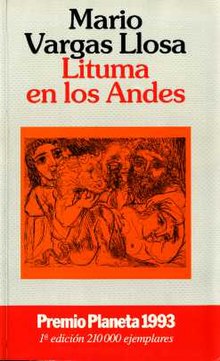Death in the Andes(Lituma en los Andes) is a 1993novelby theNobel Prize-winningPeruvianauthorMario Vargas Llosa.[1][2]Civil Guardmember Corporal Lituma has been transferred to the rural mountain town of Naccos, where he investigates the disappearances of three men, while under the constant threat ofSenderistaguerrilla attacks.
 First edition (Spanish) | |
| Author | Mario Vargas Llosa |
|---|---|
| Original title | Lituma en los Andes |
| Translator | Edith Grossman |
| Language | Spanish |
| Publisher | Planeta |
Publication date | 1993 |
| Publication place | Spain |
Published in English | 1996 |
| Media type | |
| Pages | 288 p. |
| Awards | Premio Planeta de Novela |
| ISBN | 84-08-01047-6 |
| OCLC | 36562390 |
The novel won Spain'sPremio Planeta de Novelain 1993 and was translated into English in 1996 byEdith Grossman.
Plot
editThe novel follows the character of Corporal Lituma, who previously appeared inWho Killed Palomino Molero?andThe Green House.
Civil Guardpoliceman Corporal Lituma has been transferred to the tiny Andean community of Naccos, populated almost entirely by laborers for a highway construction project on the verge of being shut down. Lituma, along with his lovesick adjutant Tomás Carreño, are tasked with investigating the disappearances of three men from the village: Demetrio Chanca, a construction foreman and former mayor on the run from the Senderistaterrucos,Casimiro Huarcaya, an albino itinerant merchant who claims to be apishtacowhen drunk, and Pedro Tinoco, a mentally disabled and mute man who had been living with the two policemen and performing chores for them.
Interwoven with the story of Lituma's investigations are vignettes about the lives of the three disappeared men, Carreño's one-sided love affair with Mercedes Trelles, and the violent deaths of tourists, ecologists, and other non-working class people at the hands of the Senderistaterrucos.
Initially convinced that theterrucoswere responsible, Lituma learns more about the spiritual history of the region and begins to suspect that Dionisio and Adriana, the socially powerful owners of the local bar, had something to do with the disappearances. Dionisio formerly led a traveling, spiritually-attunedmaenad-like cult, while Adriana helped to kill a pishtaco in her youth. Though the traveling group dispersed, Dionisio and Adriana retain mysterious power and a strong spiritual sense. Lituma becomes convinced that Adriana and Dionisio led the townspeople to sacrifice the three men to the localapusto protect themselves fromterrucos,landslides, and closure of the construction site. Though no one is killed, a massive landslide devastates the construction site anyway, and it closes. The now-jobless workers leave Naccos, and Lituma and Carreño receive new postings.
Before the two policemen depart, Mercedes arrives at their station, having had a change of heart, and reconciles with Carreño. Lituma pays a final visit to the bar, where a former worker, angry with Dionisio and Adriana, bitterly confirms Lituma's suspicion: the townspeople together sacrificed the three men and ate their testicles, a taste which he can never wash out of his mouth.
Themes
editThis novel discusses (and censures) the tactics and motivations of theShining Pathat length. It situates their violence in the context of a premodern world, where life is brutal and death is ever-present, and considers the idea that bloodshed is necessary to make things better, comparing the Shining Path's guerrilla violence toritualized human sacrifice.[2]
In the novel, Corporal Lituma encounters references to some elements of native Peruvian spirituality, includingapus,pishtacos,andmukis.His lack of understanding ofIndigenous Andeanculture is a significant obstacle in his attempts to discover the truth behind the disappearances in Naccos.
Style
editDeath in the Andesfeatures Vargas Llosa's technique of interlacing dialogues, a staple of his repertoire which he began using in his first novel, in which two conversations or events that occur at different times are combined.[3]InDeath in the Andes,this technique is used when a character is recounting a story of their own, changingindirect discoursetodirect discourseand including scene descriptions from both settings in order to create aflashbackthat feels immersive and active.
Background
editIn 1962, Vargas Llosa was asked by the Peruvian PresidentFernando Belaúnde Terryto join the Investigatory Commission, a task force to inquire into the massacre of eight journalists at the hands of the villagers ofUchuraccay.[4]This experienced inspiredWho Killed Palomino Molero?andDeath in the Andes.[5]
The book's epigraph is a quote fromWilliam Blake'sThe Ghost of Abel.
Reception
editThe novel won Spain'sPlaneta Novel Prizein 1993.
In aWashington Postreview, author and criticMarie Aranapraised the book but criticized Grossman's translation.[1]In a review of the English edition in theNew York Times,novelistMadison Smartt Belldescribed the book as "often brilliant" but "confusingly disorganized."[2]
References
edit- ^abArana-Ward, Marie (1996-02-25)."Ancient Sorceries and Modern Mysteries".The Washington Post.Archivedfrom the original on 1997-08-08.Retrieved2008-09-05.
- ^abcSmartt Bell, Madison (1996-02-18)."Mountains of the Mind".The New York Times.Archivedfrom the original on 2020-11-01.Retrieved2008-09-05.
- ^Booker 1994,p. 13
- ^Kristal 1998,pp. 150–151
- ^Franco 2002,p. 56
Sources
edit- Booker, M. Keith (1994),Vargas Llosa Among the Postmodernists,Gainesville, Florida: University Press of Florida,ISBN978-0-8130-1248-3.
- Franco, Jean(2002),The Decline and Fall of the Lettered City: Latin America in the Cold War,Harvard University Press,ISBN978-0-674-00842-7.
- Kristal, Efraín (1998),Temptation of the Word: The Novels of Mario Vargas Llosa,Nashville, Tennessee: Vanderbilt University Press,ISBN978-0-8265-1301-4.